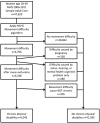Prevalence of current pregnancy among US women with and without chronic physical disabilities
- PMID: 23604018
- PMCID: PMC3733491
- DOI: 10.1097/MLR.0b013e318290218d
Prevalence of current pregnancy among US women with and without chronic physical disabilities
Abstract
Background: The number of US women of childbearing age who have chronic physical disabilities (CPD) is increasing. However, little is known about their reproductive experiences. Historically, women with physical disabilities have confronted stigmatized attitudes about becoming pregnant.
Objectives: To explore the national prevalence of current pregnancy among women with and without CPD; examine differences in current pregnancy prevalence between these 2 groups of women.
Research design: Bivariable and multivariable analyses of cross-sectional, nationally representative National Health Interview Survey data from 2006 to 2011.
Subjects: Forty-seven thousand six hundred twenty-nine civilian, noninstitutionalized women aged 18-49 years.
Measures: National Health Interview Survey asks women ages 18-49 if they are currently pregnant; it also asks about various movement difficulties. We used responses from 8 movement difficulty and other questions to identify women with CPD.
Results: Six thousand forty-three (12.7%) sampled women report CPD. Compared with other women, women with CPD are significantly: older; more likely to be black and less likely to be Asian or Hispanic; more likely to be divorced or separated; more likely to have less than a high school education; less likely to be employed; and have much lower incomes. Across all women, 3.5% report being currently pregnant: 3.8% of women without CPD and 2.0% with CPD. Controlling for sociodemographic factors, the adjusted odds ratio (95% confidence interval) of current pregnancy is 0.83 (95% confidence interval, 0.65-1.05; P=0.12) for women with CPD compared with nondisabled women.
Conclusions: Women with CPD do become pregnant, and their numbers will likely grow. Obstetrical practitioners therefore require training about the special needs of these women.
Figures
References
-
- National Institute of Child Health and Human Development, Office of the Director. [Accessed February 8, 2013];Pregnancy and women with physical disabilities. 2010 http://www.nichd.nih.gov/about/meetings/2010/012610.cfm. Updated.
-
- The Future of Disability in America. Washington, D.C.: The National Academies Press; 2007. Institute of Medicine, Committee on Disability in America Board on Health Sciences Policy.
-
- Lollar D, editor. Launching into Adulthood An Integrated Response to Support Transition of Youth with Chronic Health Conditions and Disabilities. Baltimore: Paul H. Brookes Publishing Co.; 2010.
-
- Alley DE, Chang VW. The changing relationship of obesity and disability, 1988-2004. JAMA. 2007;298(17):2020–2027. - PubMed
-
- Reilly JJ, Kelly J. Long-term impact of overweight and obesity in childhood and adolescence on morbidity and premature mortality in adulthood: Systematic review. Int J Obes (Lond) 2011;35(7):891–898. - PubMed
Publication types
MeSH terms
Grants and funding
LinkOut - more resources
Full Text Sources
Other Literature Sources
Medical


